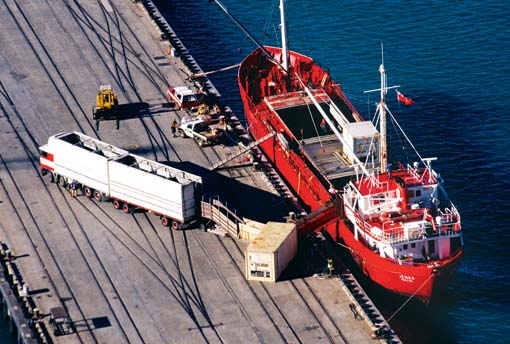The pros and pitfalls of importing livestock

Importing livestock has its supporters and its critics. Among pedigree breeders it still has the “cache” associated with acquiring something new and improved, while among commercial farmers it often triggers fears of heightened disease risks.
Most would agree that without the infusion of imported genetics, many of our livestock breeds – and none more so than the Holstein – would not have the international status they have today.
And indeed, by far the biggest volume trade in imported dairy cattle is now being driven by the demand for pedigree Holsteins as replacements in commercial UK herds. Despite the import costs, black-and-white heifers from Europe are now readily available through many UK buying agents at a price that an increasing number of milk producers regard as better value compared with UK-bred cattle.
It’s this growing import trade that has brought commercial dairy farmers into the midst of the debate over potential health risks posed by the constant stream of European cattle now underway.
Important questions
But the argument in favour of buying imported herd replacements is gaining ground with many producers. Those who remain undecided are asking the questions: Can imported stock benefit their business in terms of their cost and their production potential? What does importing actually entail? Can I rely on buying animals unseen through an agent? Do these cattle present any health risks to my herd?
So is importing livestock something worth considering and, if so, what are the advantages and the possible pitfalls?
Andrew Ewing of Dumfriesshire is at the sharp end of both imports and exports of livestock through his Annan-based business which handles more than 2,000 cattle a year.
“If you are going to import any type of livestock it’s important you fully trust the person who will be selecting the stock and arranging the importation on your behalf.
“If you aren’t able to see the stock personally you must have total confidence in your buying agent,” he says.
Mr Ewing regularly imports black-and-white cattle from Europe, as well as a few pedigree Limousin from France and Beltex sheep from Belgium.
TB test
“Importing stock isn’t as complicated as it used to be. Cattle coming into the UK have to arrive with a clear TB test certificate and the passport details to licence the movement.”
Farmers need to advise their local Animal Health Office (AHO) 24 hours before imported cattle arriving on farm. The AHO will then arrange a health check when required. Cattle are free to move off farm in the UK after six days of arrival.
“Bluetongue is no longer a major issue and cattle don’t have to be jabbed for it as long as they come from a bluetongue-free area. In my opinion there are no health risks from importing cattle, providing everything is undertaken in accordance with the regulations. Herd health standards on the farms we deal with in the EU are exceptionally high,” he says.
Robin Loxham from Lancaster, Lancashire has long been involved in the pedigree livestock business and now imports about 35 black-and-white Holstein heifers every week from Holland through his company, Global Cattle Exports.
And after 10 years of a ban on imports of live cattle into the UK from Canada, an easing in import regulations has recently enabled him to arrange the importation of three Holsteins – a cow and two heifers – for a season of summer showing.
Canadian imports
“It’s a breakthrough that will hopefully be the start of more opportunities for UK breeders to bring cattle from Canada, but the number of herds that are eligible to export to the UK is still restricted and applies only to those which are formally monitored under the CHAR scheme of health accreditation operated by the Canadian government,” says Mr Loxham.
So although only about 100 herds are now able to send Holsteins from Canada to the UK, Mr Loxham regards the move as an important step forward. Although importing from Canada can be costly, it’s relatively easy.
“Cattle are brought over per pallet load. So in this case we had one cow and the two heifers on one pallet that was flown into Heathrow. A pallet costs $9,000 (about £6,000). In addition there are loading and unloading charges at each end of the flight costing £2,000 in total, plus our charges for organising the importation,” he explains.
On health grounds he says imports from Canada pose no threat to UK herds. A blood sample is taken on arrival to test for EBL, but cattle do not have to serve any official quarantine period.
Health status
In fact he reckons the health status of cattle being imported from Holland to supply UK dairy herds is now considered a bonus rather than a risk.
“We import around 35 heifers from Holland every week and there’s no TB in the country, so that’s a big attraction, especially for milk producers in Scotland looking for herd replacements. Other diseases such as Johne’s, BVD and IBR have been eradicated in the herds we deal with,” says Mr Loxham.
Guide to importing
• Try and select stock personally
• If you have to rely on an agent, make sure you totally trust him
• Don’t get carried away with tempting offers of stock
• Make sure you AND your agent are fully aware of any health issues in the country of origin
• Check with DEFRA to arrange health checks on arrival in the UK if necessary
• Consult your vet and arrange a vet-check on arrival
• Make sure you know precisely what paperwork should accompany each animal
Vet viewpoint, Neil Howie, Nantwich Vets
 No one can say for certain that imported livestock will never present any health risk, but provided anyone considering importation thoroughly understands the health testing requirements relating to the country of origin and works with reputable suppliers, the risks will be minimised.
No one can say for certain that imported livestock will never present any health risk, but provided anyone considering importation thoroughly understands the health testing requirements relating to the country of origin and works with reputable suppliers, the risks will be minimised.
That’s the opinion of Cheshire vet Neil Howie, of Nantwich Veterinary Group, who, like many other dairy vets, had initial reservations about the increase in imports of dairy cattle arriving in the UK from Europe.
“I have to say that as the trade has developed – and we’ve had clients who have bought imported cattle – we haven’t seen any health issues apart from a few animals that haven’t travelled very well.
“But I still believe that anyone importing cattle should ensure their vet knows about it so they can sit down together and discuss the health screening of the new arrivals as soon as they are delivered to the farm. I would advise giving imported heifers a routine IBR vaccination and test them for BVD,” says Mr Howie.
He remains concerned that some importers are still giving assurances of cattle being free from Johnes’ disease.
“There is no test that will prove a young animal is free of Johnes’ disease for life. If it has come from a herd that has had Johne’s disease, there’s a risk it may bring it in. Dairy farmers do need to be aware of that, no matter where their replacements are coming from,” says Mr Howie.
Country requirements when importing stock:
The top five countries in the EU from which livestock is imported into the UK are:
• Republic of Ireland,
• Netherlands,
• Germany,
• France
• Czech Republic
Cattle for breeding and production must be tested prior to export for:
1. Brucellosis – during 30 days prior to export if more than 12 months of age. (All must originate from officially Brucellosis-free (OBF) herds.) All countries above are free.
2. TB – during 30 days prior to export (if more than six weeks old and coming from non-OTF (officially TB-free) countries/regions.) All need to come from OTF herds. All five countries, except Republic of Ireland, are free.
3. EBL – 30 days prior to export if more than 12 months old and when coming from non-EBL free countries/regions. All five countries, except Czech Republic, are free.
4. Bluetongue – importers have an option of vaccination plus testing, if they don’t want or are unable to comply with vaccination, plus 60 days wait or re-vaccination as per manufacturer’s recommendations. This is for all susceptible animals.
5. All animals must comply with many other requirements that provide reassurance of their health status.
Sheep and Goats must be tested prior to export:
• Rams for breeding have to be tested for Brucella ovis 30 days prior to export.
• Sheep and Goats have to comply with a scrapie monitoring scheme, if not they would be tested for scrapie prior to export.
• Bluetongue – importers have an option of vaccination plus testing if they don’t want or are unable to comply with vaccination plus 60 days wait or re-vaccination as per manufacturer’s recommendations. This for all susceptible animals.
6. All have to comply with many other requirements that provide reassurance of their health status.
SHEEP IMPORTS CASE STUDY
Steve Gibbons will be importing around 90 pedigree Beltex ewes this year. It’s something he’s been doing for the last 10 years as he continues to strengthen the flock’s genetics – and he says importing is a “very straightforward operation”.
“The import protocol is very strict, but that doesn’t mean it’s complicated,” says Mr Gibbons, who uses breed society agents in Belgium and Holland to select sheep on his behalf.
Well known for his successes at winter primestock shows, Steve runs 600 ewes at Llwynbrain Farm near Hay-on-Wye. As well as Beltex ewes, he’s also importing a batch of Charollais from France which will be used in his Beltex x Charollais-cross breeding programme.
His imported sheep undergo two Bluetongue tests and a maedi visna test before leaving for the UK. The tests take around 12 weeks to complete at a total cots of £45. On arrival in the UK the DVO is notified and is provided with the relevant documentation.
“We work closely with some excellent hauliers but have to make sure we plan the route precisely. The sheep have water available in transit but the wagon makes the trip over in one non-stop journey.
“I’ve never had any problems and provided you abide by all the rules and follow everything to the letter, importing isn’t difficult. And there’s no doubt that the standards of flock health in the countries we deal with are exceptionally high and the regulations breeders have to work with are even stricter than here in the UK,” says Mr Gibbons.
